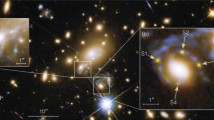Gravitational lensing – i.e. light deflection by gravity – has become an important tool for exploring our Universe, in particular to determine its matter content. There are cases in which the deflection angles are tiny, of the order of milliarcseconds or smaller, such that the multiple images are not observable. However, lensing magnifies the affected source, and since the lens and the source are moving relative to each other, this can be detected as a time-variable brightness. This behaviour is referred to as gravitational microlensing, a very powerful method to search for dark matter in the halo of our own Galaxy, if it consists of massive astrophysical compact halo objects (MACHOs), and to study the content of low-mass stars in the galactic disk. Since the discovery of the first microlensing events in September 1993 by monitoring millions of stars in the Large Magellanic Cloud (LMC) and in the direction of the galactic centre, more than 200 events have been found. Preliminary analysis of the events towards the LMC indicate that the halo dark-matter fraction in the form of MACHOs is of the order of 50%, assuming a standard spherical halo model. This article provides an overview of gravitational microlensing and of the main results achieved so far. Indeed, gravitational microlensing research has expanded very rapidly in the last few years, and many new applications have been suggested, including the detection of Earth-like planets around stars in our Galaxy.
Similar content being viewed by others
Author information
Authors and Affiliations
Rights and permissions
About this article
Cite this article
Jetzer, P. Gravitational Microlensing. Naturwissenschaften 86, 201–211 (1999). https://doi.org/10.1007/s001140050599
Issue Date:
DOI: https://doi.org/10.1007/s001140050599




